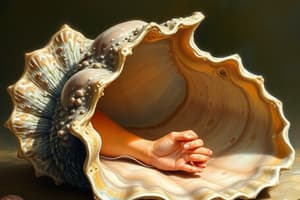Podcast
Questions and Answers
What is Phylum Mollusca?
What is Phylum Mollusca?
- Soft-bodied animals with an internal shell (correct)
- Soft-bodied animals with an external shell (correct)
- Soft-bodied animals that may or may not have a shell (correct)
- Hard-bodied animals with an external shell
What organisms are classified under Class Bivalvia?
What organisms are classified under Class Bivalvia?
Clams, scallops, mussels, and oysters
What is a true coelom?
What is a true coelom?
A body cavity completely lined with tissue derived from mesoderm
An open circulatory system allows blood to flow entirely within blood vessels.
An open circulatory system allows blood to flow entirely within blood vessels.
What is a complete digestive system?
What is a complete digestive system?
Many freshwater clams have a ___ larval stage that attaches to the gills of fish and lives as a parasite for a few weeks.
Many freshwater clams have a ___ larval stage that attaches to the gills of fish and lives as a parasite for a few weeks.
What are zygotes?
What are zygotes?
Bivalves have two shells (valves) that are laterally compressed and dorsally hinged, known as ___.
Bivalves have two shells (valves) that are laterally compressed and dorsally hinged, known as ___.
What is the function of siphons in bivalves?
What is the function of siphons in bivalves?
What does the hinge ligament do?
What does the hinge ligament do?
The shells are hinged at one end; the hinge is known as the ___.
The shells are hinged at one end; the hinge is known as the ___.
What is the function of the anterior adductor muscle?
What is the function of the anterior adductor muscle?
What is the posterior adductor muscle?
What is the posterior adductor muscle?
What is a pallial line?
What is a pallial line?
What do ostia do?
What do ostia do?
What is the role of the ventricle in the heart?
What is the role of the ventricle in the heart?
What is the auricle in the heart?
What is the auricle in the heart?
What is the anterior aorta?
What is the anterior aorta?
What structure receives incoming water in bivalves?
What structure receives incoming water in bivalves?
What does the excurrent aperture do?
What does the excurrent aperture do?
What is the nacreous layer?
What is the nacreous layer?
What is the visceral mass?
What is the visceral mass?
What are gill lamellae?
What are gill lamellae?
What are water tubes in bivalves?
What are water tubes in bivalves?
What is the coelomic cavity?
What is the coelomic cavity?
Flashcards are hidden until you start studying
Study Notes
Phylum Mollusca
- Soft-bodied animals with internal or external shells.
Class Bivalvia
- Includes clams, scallops, mussels, and oysters.
- Characterized by two shells (valves) hinged at the umbo, lacking a radula.
True Coelom
- A body cavity fully lined with a tissue derived from the mesoderm.
Open Circulatory System
- Blood flows out of vessels and into body cavities, allowing direct contact with cells.
Complete Digestive System
- Animals possess both a mouth and anus, allowing food to travel in one direction.
Glochidium
- A specialized larval stage in many freshwater clams that attaches to fish gills and lives as a parasite temporarily.
Zygotes
- Fertilized eggs resulting from the union of male and female gametes.
Valves
- Bivalves have two laterally compressed shells that are dorsally hinged.
Siphons
- Structures used for pumping water in and out of the body.
Hinge Ligament
- Connects the two valves at the dorsal end.
Umbo
- The hinged end of the bivalve shell.
Anterior Adductor
- The muscle closest to the umbo aiding in keeping the clam shut.
Posterior Adductor
- The muscle furthest from the umbo, also assists in closing the clam.
Pallial Line
- A line on the inner side of each valve indicating muscle attachment around the mantle margin.
Incurrent Aperture
- The opening that receives incoming water for feeding and respiration.
Excurrent Aperture
- The opening through which water exits the bivalve.
Ventricle
- The thicker and larger lower chamber of the heart that pumps blood.
Auricle
- The upper chamber of the heart that receives blood from the veins.
Anterior Aorta
- Carries blood from the heart to the anterior body regions and head.
Posterior Aorta
- Delivers hemolymph to the rectum and mantle region.
Nacreous Layer
- A layer of calcium carbonate over protein, secreted throughout the mollusk's life. It's utilized in jewelry and can form pearls when irritants enter the body.
Pericardial Sac
- The membrane covering the heart's surface.
Visceral Mass
- The area beneath the mantle containing vital internal organs of the mollusk.
Gill Lamella
- Comprises one of the numerous sheet-like structures in gills containing a capillary bed.
Water Tubes
- Large empty spaces in the gills that help in water flow over the gill surfaces.
Coelomic Cavity
- The space between the body wall and the digestive tract.
Reproduction in Clams
- Specific details on reproductive processes in clams are not provided in the notes.
Studying That Suits You
Use AI to generate personalized quizzes and flashcards to suit your learning preferences.




